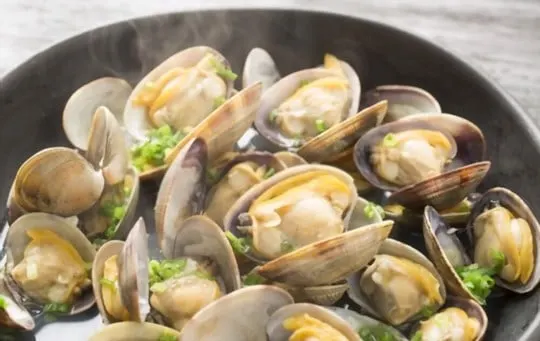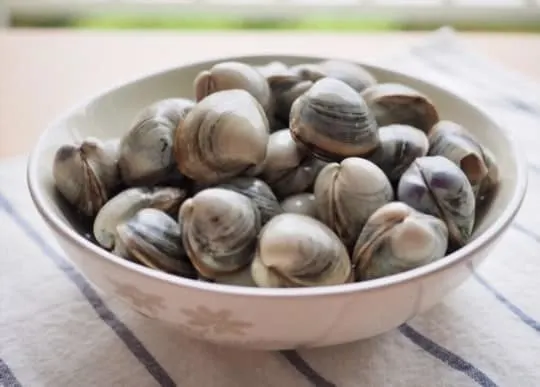Clams are a type of shellfish that is popular in Mediterranean and Asian cuisine.
There are many different types of clams, but the most common ones include littleneck, cherrystone, and Manila.
Clams can be eaten raw or cooked in numerous ways, including steaming, frying, or baking them with breadcrumbs.
It’s not uncommon to hear someone say, “I don’t know what clam tastes like.
” This blog post will give you all the information about cooking clams and what do clams taste like.
What are Clams?

Clams are a type of mollusk that typically inhabit saltwater environments, though some freshwater species exist.
The clams grow shells out of calcium carbonate, which they extract from the water and other materials such as algae and sand.
These animals typically live buried in sediment with only one end exposed (usually under the sand) for feeding purposes.
The clam’s shell closes tightly over this area as protection against predators such as crabs, fish, and birds who might want the tasty meal inside.
Clam shapes vary widely depending upon species, but you will often find clams shaped like a round disk.
Clams are an essential source of food in many countries and provide fishing bait, supplements for the poultry industry, and some medicinal benefits.
They can be eaten raw or cooked and are usually served with pasta, rice, or potatoes.
Clams should not be eaten if they smell fishy, as this means that the clam has gone bad and contains bacteria that will make you sick.
There are other types of claims, such as cockles, mussels, and oysters, but these tend to have more delicate flavors than clams do, so it is worth trying different varieties for yourself.
Health and Nutritional Benefits of Clams

Clams are a popular food that has many benefits for your health.
Clams are a great source of vitamin B12, copper, and zinc.
They also contain selenium which helps protect cells from oxidative damage caused by free radicals that contribute to aging and diseases like cancer.
These antioxidant properties can fight off age-related effects on skin or even cancers triggered by inflammation due to smoke inhalation or radiation exposure.
Clams are a high-protein, low-calorie food that makes an excellent addition to any diet.
They are high in amino acids and the essential fatty acid omega-three, which, when combined with their nutrient profile, can help lower cholesterol and triglycerides while increasing HDL (good) cholesterol levels.
Clams also contain many minerals like iron, phosphorus, potassium, magnesium, copper, zinc, and many B vitamins such as vitamin A.
Clams have an excellent protein ratio to calories, so they should be incorporated into your diet for weight loss or maintenance.
Signs That Your Clams Have Gone Bad

My favorite appetizer is usually clams, but this time they turned out a little too rubbery, and I couldn’t seem to get the taste of them off my tongue.
There are some signs that your clams may have gone bad.
However, they can still be cooked and eaten.
One of the first things to look out for is an unpleasant smell coming from the package or even just a hint in its odor when you open it up.
One more sign that could be a contributor to spoilage is the presence of any foul-smelling liquid on top.
Mould can also grow deep inside their shell where no one can see it without peeling off the clam’s skin and looking with a thin implement such as a knife tip.
If you notice any of these signs, then it’s time to discard the clams:
- The clams have a sour smell or taste.
- They are broken, and their insides ooze out when they’re opened.
- There is some grey mucus on the clam meat.
Can You Eat Clams Raw?

Clams are often thought of as a poor second option to oysters, but they can be enjoyed raw and cooked.
The clam can be eaten both raw and cooked.
Smaller clams such as littlenecks or cherries are the best for raw consumption, while larger ones like quahogs or mahogany may not be good for raw consumption but more suitable in other ways (quahogs are best for chowders).
That being said, raw clams can be dangerous because there’s a possibility of getting shellfish poisoning.
Shellfish poisonings come from eating certain types of seafood like oysters or mussels, which contain bacteria called Vibrio vulnificus.
This type of bacterium causes nausea, vomiting, diarrhea and abdominal pain in some cases, and fever.
What Do Clams Taste Like?

Clams are delicious, and what they taste like will depend on the time of year.
In general, clams can be sweet or salty, depending mainly upon where they live in their habitat.
Like its cousin, the oyster, the clam’s flavor is greatly affected by where it lives in its ecosystem.
Summertime clams are sweeter because they feed on plankton and other nutrients that wash up from the shoreline.
In contrast, wintertime clams will be saltier as their diet consists of algae found deep below the water’s surface.
Both are excellent choices if you prefer a milder taste or avoid any potentially bitter flavors that might come with more robust tasting varieties like quahogs when eaten out-of-season.
If you’re looking for a more distinctive flavor profile, try some steamed littleneck clams served over linguine drizzled with white wine sauce or garlic butter sauce.
Clams are known for their salty taste, but salinity is more in line with the sea.
They have a fishy flavor that isn’t overpowering and has neither a gross or pleasant taste
Oysters vs Clams vs Mussels vs Scallops

Oysters, clams, mussels, and scallops are all classified as bivalves.
There is no need to worry about which one you should be eating because they all taste different but equally delicious.
If you’re looking for a fresh shellfish dish, oysters are your best bet.
Oyster shells have some of the most beautiful colors in nature, and they come from all over the world.
These coveted delicacies can make or break any good meal because their texture is so delicate that it’s hard to find substitutes with similar flavor profiles.
Suppose an unadventurous eater wants something less intimidating than raw clam meat.
In that case, mussels might be more up their alley – remember to buy them live instead of canned if possible (they’ll bring out way more delicious flavors).
Scallops offer a nice variety, too, since there are two types: sea scallops and bay scallops.
Bay scallops are smaller in size but pack more punch with a sweeter flavor, whereas sea or deep-sea scallops can be much larger, and the meat is less tender due to being more plunging into the water column it’s colder.
Clams are the perfect choice for a more accessible dinner option – they’re easy to find and are often on sale when oysters aren’t.
Moreover, they’re good for novice oyster eaters who might be feeling a little apprehensive about the texture or flavor.
Clams also offer plenty of variety in preparation styles, as they can be steamed, fried, baked in their shells with spices and herbs – even grilled if you want something different.
How to Cook Clams?

Picking out the right kind of clams is key to cooking them correctly.
There are two different types, hard shells and soft shells, that you can choose from.
Hard-shelled clams have a more delicate flavor, but they don’t travel as well in ice packs, so that ordering may be difficult.
Soft-shelled clams are easy to find and easier to ship because they’re typically frozen and shipped all over the country.
There are several ways to prepare clams, and a few methods are listed below.
- Boiling: Boil the water with salt until it starts to turn cloudy, then add your clams in for about three minutes or so, according to recipe instructions.
- Steaming: Place clams in a steamer pot or colander. Cover with an inch of water, bring to a boil, and then cook for about five minutes. Serve immediately after cooking.
- Braising: Place the shelled clams on top of some aromatics like onion or thyme, cover with stock, wine, and tomato sauce (depending on what you’re going for) and simmer until they open up–about 20-25 min. *If using dried herbs, add those at the beginning. You can also use fresh minced garlic if desired. A bay leaf is helpful as well if you have one around. When finished cooking, remove from heat & discard any unopened ones.
- Stir-frying: Stir-fry your prepared clams with garlic, butter, white wine (or other liquids), and parsley until they are fully cooked.
- Grilling: Grill your hard-shelled clams by placing them on top of hot coals for about five minutes or more, depending on how you want them done. Serve with lemon wedges, butter, and parsley.
The best time to enjoy fresh clams is when they are available in their natural, new state.
How to Know if Frozen Clams are Good When Cooked?

Frozen clams are an excellent option for anyone looking to add some variety to their cooking repertoire.
They can be cooked like any other seafood, but they might require slightly more time on the stovetop or oven because of how frozen they were when you bought them.
For the best clams, inspect each clam before you eat it.
Discard those with signs of decay such as slime near openings and dark discoloration around edges.
Moreover, discard any clams with broken shells.
If you’re not sure, give them a tap to see if they sound hollow.
Clams should be cooked until the edges curl and turn white or opaque from cooking liquid (or for about five minutes).
To test their doneness, cut into one of the more big clam’s bellies to check that it isn’t too chewy inside.
Conclusion
In conclusion, Clams are a popular seafood option that can be enjoyed in many different ways, such as raw or steamed.
Whether you like them fried with garlic, grilled over an open flame, or cooked and served on the half shell, clams have something for everyone.
It’s time to try these delicious mollusks.

What Do Clams Taste Like? Do Clams Taste Good?
Ingredients
- Clams
- Ingredients from your favorite recipes
Instructions
- Depending on the recipes you choose, the taste can vastly differ.
- For authentic results, it is important to choose a recipe that will highlight the original flavor.
- Have fun experimenting with different recipes and taste tests!
